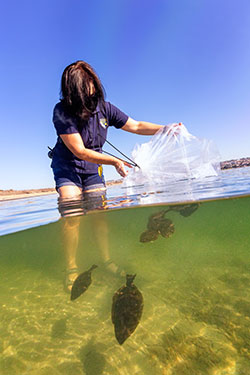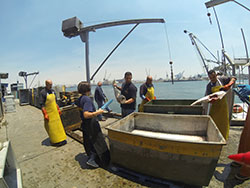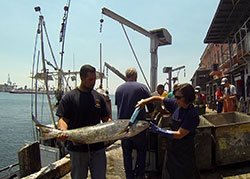Valerie Taylor, CDFW Marine Biologist

Assisting Hubbs-SeaWorld Research Institute in release of halibut. Click to enlarge

Scanning White Seabass, caught by commercial fisherman. Click to enlarge

Scanning White Seabass, at fish market in San Pedro. Click to enlarge
Valerie Taylor knew in grade school that she wanted to be a marine biologist. There was just one potential hurdle – she was living in Kingman, Arizona, about halfway between Phoenix and Las Vegas. So it wasn’t a surprise to anyone who knew Valerie that her college education would take her to California, where she earned a Bachelor of Science at California State University Long Beach.
A couple dozen years later, Valerie is now the Ocean Resources Enhancement and Hatchery Program (OREHP) Coordinator for CDFW’s Marine Region. That’s a long-winded way of saying she oversees the program that produces and releases white seabass into the Pacific Ocean. OREHP is an experimental hatchery program investigating the feasibility of using cultured (farmed) marine fish to successfully enhance wild populations. It is the only program of its kind on the west coast of North America.
How did an Arizona kid become interested in marine biology?
I grew up loving animals, so I really wanted to work in some form of science. I was very interested in the environment and gravitated toward marine biology. We had a career day at the end of fifth grade and I wore a bathing suit, because, you know, all marine biologists wear bathing suits to work (ha!).
People might be surprised to learn that CDFW has a hatchery program associated with the sea (as opposed to rivers and other inland waterways). How unusual is that?
It’s very unusual because this program works with marine fish. It’s not salmon or trout. We’re specifically looking to learn how we can enhance fisheries or wild populations through stocking.
Hubbs-SeaWorld Research Institute (HSWRI) owns the hatchery in Carlsbad, and we contract with them to raise the white seabass. When the program started in 1983, there were two species of interest that were facing a decline and were therefore specifically of interest to recreational fishermen. Those were California halibut and white seabass. Initially, OREHP staff were doing stocking research on both, but in 1990 it was determined the program didn’t have enough funding to work with two species. We decided to concentrate on white seabass going forward, because the numbers of California halibut were starting to increase, while the white seabass were continuing to decline.
Where do the white seabass eggs come from, and how do we go about releasing them once they reach a certain age?
HSWRI collects wild white seabass off the coast of Southern California for broodstock. The fish are divided into tanks based on whether they’re male or female, and they spawn year-round. The eggs are collected and within the hatchery environment the fish are raised to around 4 to 6 inches. When they reach that size, they’re tagged with an internal coded wire tag (CWT) and are checked for diseases by Department pathologists.
Throughout Southern California we have volunteer grow-out facilities, which are pens in harbors run by fishing groups or nonprofits. The fish are either trucked or taken by boat to one of those pens, where they’re raised for an additional 4 to 6 months. The pens allow them to grow to a larger size before release, giving them a better chance at survival. Once they’re around 10 to 12 inches in length, they’re released from the pens.
Are the fish eventually caught and studied to see how well they’re doing?
Yes, there are two sampling programs used to assess the proportion of hatchery-raised fish to the wild population. The juvenile sampling program has been conducted, off-and-on, since 1988. Gill nets are deployed in nearshore coastal and embayment areas off Southern California from Palos Verdes south to Imperial Beach off San Diego to recover white seabass that have been released by the OREHP. Data on these captured fish and how many have CWTs are used to estimate survivorship and to determine how release habitat, region, and seasonality affect their survivorship. In addition, this sampling is used to determine the spatial and size distributions, seasonality, and abundance of wild young white seabass in shallow (5-10 meter) nearshore waters.
There’s also an adult sampling program that has been ongoing since 1998. CDFW staff, along with HSWRI, opportunistically scan white seabass caught by both the commercial and recreational fisheries for a CWT. The OREHP has freezers at various organizations and sportfish landings within Southern California where sport fishermen can drop off their seabass heads. The heads are then collected and scanned for CWTs by HSWRI. CDFW also employs staff who scan white seabass as the fish are being offloaded by commercial and recreational fishermen in Southern California.
Is the goal of the program simply to increase the population?
When the OREHP began in 1983, the intent of the program was to investigate the economic and ecological feasibility of spawning, rearing, and releasing important marine fish of Southern California. Since then, the intent of the program has been modified slightly, with the ultimate goal now being to increase (enhance) marine fish populations that are important to California commercial and sport fishing.
In this process, do we learn the causes of fish populations thriving or declining? Are there conclusions on what has happened to white seabass?
The OREHP has certainly contributed significantly to our knowledge on white seabass life history, which in turn has improved management decisions for this species, but the program’s research is not focused on learning the causes of why fish populations thrive or decline. The decline of the white seabass population was most likely attributed to human activities (pollution, overfishing and habitat destruction) and natural environmental conditions. The increase we’ve seen in the population is thought to be a combination of both environmental and fishery management actions.
OREHP has been described as an “experimental” program. What makes it experimental?
The program is experimental in that it is constantly improving and discovering new science and marine enhancement techniques. For example, we used to release juvenile white seabass year-round, either from the hatchery or at a grow-out facility. But a 2008 study concluded there is a higher survival rate when the release happens during the spring, summer, or fall. We’ve adjusted the releases based on that study.
In August 2014, the two millionth white seabass was released. That sounds impressive!
The August 2014 milestone was important, but since then, our number has grown to more than 2.5 million released!
Also, back in 2015, our oldest tagged fish was recovered off Ventura. That was a 15-year-old female. These fish can live beyond 30 years and the oldest white seabass caught was 28 years old. We don’t know how often that fish would have spawned, but it has been reported that white seabass spawn more than once per season.
How did that make you feel?
It was a nice feeling to know the fish were surviving – we had the proof. It made everybody feel good about the program, and it felt like we were making a difference.
What’s been the most rewarding thing about being assigned to this hatchery program?
The most rewarding part of this program is all the different groups and people that I get to work with on a daily basis. As coordinator, I’ve had the pleasure of working side-by-side with nonprofits, commercial fishermen and businesses, recreational fishing groups, various researchers, and a variety of K-12 schools within Southern California. All the different ideas and personalities have certainly made my job challenging at times, but it’s been worth it to see everyone focused on the importance of maintaining healthy and sustainable wild fish populations.
###
CDFW Photos